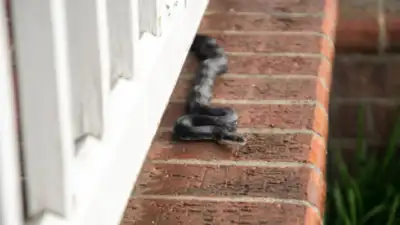
Few things make your heart race quite like spotting a snake slithering nearby. Whether you live near the woods, in a quiet suburb, or even on a farm, snakes don’t really care about your ZIP code. If they find shelter, food, or water in or around your home, they’ll move right in. The worst part? You might not even realize they’re there—until it’s too late. But don’t panic just yet. Snakes usually give off subtle signs before they make a full-blown appearance. If you pay attention, you might just spot the red flags early. So here are a few warning signs that could mean a snake is lurking near your house.
Shed snake skin
Let’s start with the most obvious clue: shed skin. Snakes regularly shed their skin as they grow. If you spot a papery, translucent snake skin in your garden, attic, garage, or near water pipes, it means one thing—a snake has been there recently. The skin often looks like a crumpled plastic sleeve and is usually found near rocks, woodpiles, or in dark corners where they hide. It’s nature’s version of a calling card.
Slither tracks in dust or mud
If you’ve got a dusty garage floor, muddy garden beds, or sandy pathways around the house, look closely. Slither marks or wave-like trails can indicate that a snake has recently passed through. These tracks usually look like a side-to-side “S” pattern. Not all animals leave prints—some leave glides.
Strange pet behavior
Your pets often know before you do. Dogs might start barking or growling at a particular spot in the yard or home, while cats may appear overly curious or hissy around certain areas. If your pet is fixated on a dark corner, bush, or under the porch and won’t leave it alone, take the hint. They could be detecting movement or scent that’s invisible to you.
Sudden decline in rodents or frogs
If your backyard used to have lots of mice, rats, frogs, or lizards—and suddenly you’re seeing none—that might not be good news. Snakes are natural predators. They’ll hang around as long as the food supply is strong. And if the prey has mysteriously disappeared, there’s a good chance the predator is still nearby, full and hiding.
Unusual droppings
Snake droppings are rare to spot, but they’re very distinct. They’re dark and mushy with a white tip (that’s the uric acid snakes excrete). You might find these in garages, sheds, or corners of your yard. Unlike dog or cat poop, they don’t usually have a regular shape. If you’re seeing strange droppings and it’s clearly not from your pet, keep your eyes peeled.
Hissing or rustling sounds
Snakes are quiet—until they’re not. Some species hiss or make a low growling sound when threatened. More commonly, you might hear rustling in dry leaves, bushes, or ceilings, especially at dawn or dusk when snakes tend to be more active. If you hear something that sounds like dry leaves shifting but there’s no wind—investigate, carefully.
Snake holes or burrows
Snakes don’t always dig their own holes, but they’ll gladly move into abandoned rodent tunnels, termite holes, or compost piles. These snake “doorways” are usually found near foundations, under sheds, or in overgrown parts of your yard. If you spot a small, round, smooth-edged hole in the soil, don’t go poking around with your fingers.
Nesting materials in strange places
This one’s especially important if you have firewood stacks, hay bales, or piles of unused building materials. Snakes love hiding in warm, undisturbed places. If you start to notice nesting material—shredded paper, dry leaves, or straw—in tight spaces you haven’t touched in a while, be cautious. Even though snakes don’t build nests like birds, they’ll hide in places where other animals have nested before.
Water sources around the house
Do you have bird baths, koi ponds, leaky hoses, or rainwater collectors? These are not just hydration stations for birds and bugs—they’re snake magnets. Especially in hot climates or during dry seasons, snakes will travel in search of water. If your backyard is their version of an oasis, you might be welcoming more than just butterflies.
You’ve seen one—there might be more
This seems obvious, but people often underestimate it. If you’ve seen even one snake, especially a juvenile, there might be more. Some snake species lay dozens of eggs at once. Others give birth to live young. A single snake sighting could mean you’re near a nesting site, and that’s not something to ignore.
So, what should you do if you notice these signs?
First, don’t panic. Not all snakes are dangerous, and many are actually helpful—keeping rats, pests, and insects in check. But if you suspect a venomous snake or just don’t want any uninvited reptiles around, here’s what you can do:
- Seal up cracks and holes around your home’s foundation.
- Trim bushes, grass, and shrubs regularly. Tall vegetation is a snake’s playground.
- Keep firewood and building materials off the ground and away from walls.
- Avoid leaving pet food outside, which could attract rodents and, in turn, snakes.
- If you spot a snake, don’t try to handle it yourself—call animal control or a licensed snake removal expert.
Stay alert, not afraid
Snakes aren’t out to get you. They’re usually just looking for food, water, or shelter—and your cozy backyard might be checking all their boxes. The good news? They often leave behind signs that they’ve moved in.By learning to spot the clues early, you can prevent a close encounter and keep your home and family safe—without freaking out or reaching for a shovel.Stay alert, stay calm, and when in doubt, call in the pros.Disclaimer: The information in this article is intended for general awareness and educational purposes only. It is not a substitute for professional pest control or wildlife management advice. If you suspect a snake is in or around your home, do not attempt to handle or remove it yourself. Always contact a licensed wildlife expert or local animal control authorities. The author and publisher are not responsible for any harm or injury resulting from the use or misuse of the information provided.







